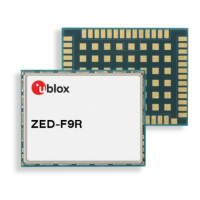ZED-F9R-Integration manual
Configuring the properties of the secondary output navigation solution: Optionally, it is possible
to configure the properties of the secondary output navigation solution in order to adapt it to the
application's needs.
A minimal subset of the primary output navigation solution configuration is available for the
secondary output navigation solution configuration. All such available configuration items are in the
CFG-NAV2-* configuration group (see applicable interface description [2]).
Configuring any of the CFG-NAV2-* configuration items changes the behavior of the secondary
output navigation solution only and not the primary output one. All such configuration items have a
primary output configuration counterpart and have the same default value as their primary output
configuration counterpart.
For example, the CFG-NAV2-SBAS_USE_INTEGRITY configuration item allows configuring the
SBAS integrity feature differently for the primary output and the secondary output. Its primary
output counterpart is the CFG-SBAS-USE_INTEGRITY configuration item and the default value of
both configuration items is the same.
3.4.3 Expected output behavior
Once the secondary output is enabled and the desired secondary output UBX-NAV2-* messages
are configured, the ZED-F9R will output both primary and secondary output data in the form of the
enabled UBX-NAV-* and UBX-NAV2-* messages respectively.
In every navigation epoch, a set of UBX-NAV-* messages will be output followed by another set of
UBX-NAV2-* messages. Both sets will be referring to the navigation solution of the same navigation
epoch.
Each set will be delimited at its end with a UBX-NAV-EOE or a UBX-NAV2-EOE message respectively.
In other words, a UBX-NAV-EOE message will be output at the end of the UBX-NAV-* class enabled
messages and a UBX-NAV2-EOE message will be output at the end of the UBX-NAV2-* class enabled
messages. For example, if only UBX-NAV-PVT, UBX-NAV2-PVT, UBX-NAV-TIMEGPS and UBX-NAV2-
TIMEGPS are enabled on the same port with message output rate 1, then every navigation epoch
output will be as follows: UBX-NAV-PVT, UBX-NAV-TIMEGPS, UBX-NAV-EOE, UBX-NAV2-PVT, UBX-
NAV2-TIMEGPS, UBX-NAV2-EOE.
Secondary output messages appear after the primary output messages. This results in a
higher latency for the secondary output messages than the primary output messages.
Contrary to UBX-NAV2-* messages, secondary output NMEA-NAV2-* messages are not
delimited by an NMEA-equivalent to UBX-NAV-EOE.
The specification of the UBX-NAV2-* messages resembles that of the UBX-NAV-* messages. The
payload specification of a UBX-NAV2 message is identical to the payload specification of its UBX-
NAV counterpart, allowing to easily adapt any existing message parsers. The primary output will
contain results and data reflecting the full navigation solution of the ZED-F9R. The secondary
output will contain results and data reporting a GNSS standalone navigation solution.
3.4.4 Example use cases
As an example, an application using a ZED-F9R that is operating in RTK sensor fusion mode
can enable the secondary output and monitor a GNSS standalone solution to understand the
improvements introduced by using high precision sensor fusion.
UBX-20039643 - R06
3 Receiver functionality Page 45 of 119
C1-Public

